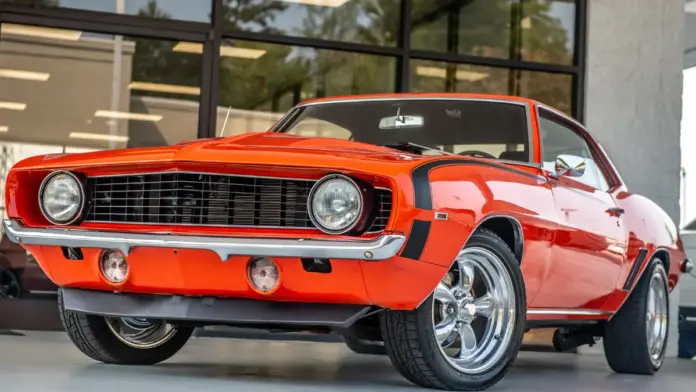In an era where cutting-edge technology is revolutionizing every aspect of our lives, it’s fascinating to witness how vintage cars, those relics of a bygone era, are embracing modern technology to enhance performance, safety, and overall driving experience. These classic beauties are not merely nostalgic remnants of the past but are evolving with the times, integrating innovative advancements seamlessly while preserving their timeless charm. In this blog post, we’ll explore the intriguing intersection of vintage cars and modern technology, delving into how these cherished automobiles adapt and thrive in the digital age.
Vintage cars, with their elegant designs and rich history, evoke a sense of nostalgia and admiration among enthusiasts and collectors alike. However, beneath their timeless exteriors lies a world of possibilities waiting to be unlocked through modern technological innovations. One of the most significant advancements in recent years is the integration of smart features and connectivity solutions, transforming vintage cars into sophisticated driving machines.
One area where modern technology has made a substantial impact is in enhancing safety features. While vintage cars may lack the advanced safety systems found in contemporary vehicles, retrofitting them with modern safety technologies has become increasingly popular among collectors. From anti-lock braking systems (ABS) to traction control and electronic stability control (ESC), these upgrades not only improve safety but also ensure a smoother and more controlled driving experience.
Moreover, the advent of advanced driver assistance systems (ADAS) has revolutionized the way vintage cars navigate the roads. Features such as adaptive cruise control, lane-keeping assist, and collision avoidance systems are now being incorporated into classic models, offering drivers an added layer of safety and convenience without compromising the authenticity of the vehicle.
But safety enhancements are just the tip of the iceberg when it comes to modernizing vintage cars. Another significant trend is the integration of digital infotainment systems and connectivity options, bringing classic automobiles into the digital age. Whether it’s installing touchscreen displays, Bluetooth connectivity, or smartphone integration, these upgrades allow drivers to enjoy modern amenities while preserving the vintage aesthetic of their beloved cars.
Furthermore, automotive engineering advancements have led to performance and fuel efficiency improvements, even in vintage models. The retrofitting of modern engines, transmission systems, and fuel injection technologies has revitalized the driving experience, offering increased power, responsiveness, and efficiency without compromising the authenticity of the vehicle’s design.
One prime example of this fusion of old and new is the rise of electric conversions for vintage cars. With the growing emphasis on sustainability and environmental consciousness, many enthusiasts are opting to convert their classic automobiles into electric vehicles (EVs). Electric conversions not only reduce emissions but also provide a unique driving experience, combining the timeless appeal of vintage cars with the silent, smooth power of electric motors.
Moreover, electric conversions open up a world of possibilities for vintage car enthusiasts, allowing them to take advantage of regenerative braking, instant torque, and seamless acceleration. While purists may initially balk at the idea of replacing the traditional internal combustion engine, the allure of electric propulsion is undeniable, offering a glimpse into the future of automotive technology while preserving the heritage of the past.
In addition to safety, performance, and sustainability, modern technology is also transforming how vintage cars are restored and maintained. The advent of 3D printing, for instance, has revolutionized the production of rare and obsolete parts, making it easier and more cost-effective to restore vintage automobiles to their former glory. From intricate interior components to complex engine parts, 3D printing allows enthusiasts to recreate virtually any part with precision and accuracy, ensuring that these classic cars remain on the road for generations to come.
Furthermore, the internet and social media have facilitated the exchange of knowledge and expertise among vintage car enthusiasts worldwide. Online forums, video tutorials, and social media groups provide a platform for enthusiasts to share tips, advice, and restoration projects, fostering a vibrant community dedicated to preserving and celebrating these automotive treasures.
But beyond the realm of restoration and modification, modern technology is also shaping the way vintage cars are showcased and appreciated by enthusiasts and the general public alike. Virtual reality (VR) experiences and augmented reality (AR) apps allow individuals to explore vintage car collections and museums from the comfort of their homes, providing an immersive and educational experience for enthusiasts of all ages.
Moreover, the advent of online auctions and digital marketplaces has made it easier than ever for collectors to buy, sell, and trade vintage cars and parts, expanding the reach of the vintage car community beyond geographical boundaries. Whether you’re searching for a rare classic or looking to sell a cherished vehicle, the digital marketplace offers unparalleled convenience and accessibility, connecting enthusiasts from around the world.
In conclusion, the marriage of vintage cars and modern technology represents a harmonious blend of tradition and innovation. While these classic automobiles may hail from a bygone era, they are far from obsolete, evolving with the times to embrace the latest advancements in safety, performance, connectivity, and preservation. As we look to the future, it’s clear that these timeless classics will continue to captivate and inspire generations of enthusiasts, bridging the gap between the past and the present in remarkable ways.



